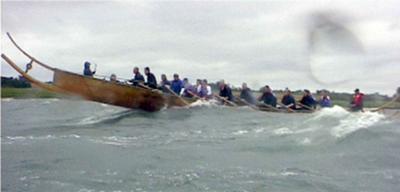Started Sailing
On the possible origins of the wooden hull.
by Han
(Brittany, France)

The Iron-age Hjortspring-boat taking a beating.
In contrast with the skin-on-frame-boats (coracle, currach and kayak) which we've read about in the first two articles, the development of the wooden hull took place in wooded areas, where oak-trunks of sufficient length and width were available in abundance.
According to one theory the first kind of "boat" was the raft, built originally for the efficient transportation of large quantities of wood, on which also stones could be taken along. The next logical step would have been to put the longest trunks in the centre, the shorter ones to the left and right, and to build up the sides; if you then succeeded in closing the gaps in-between, you'd have got the raw prototype of a flat-bottom boat.
Some archeological finds along the former Roman border in Germany and Holland support this theory: see: http://www.msnbc.msn.com/id/3226785/ and: http://www.monstersandcritics.com/science/features/article_1379573.php
Another theory has as a starting-point the dugout-canoe. See: http://en.wikipedia.org/wiki/Dugout_(boat). If a dugout is sufficiently heated by fire, the sides can be bent outward to the shape (in cross-section) of a shallow bowl, and if you then build up the sides with one or two planks sewn on top clinkerwise, you've got the first prototype of a Viking boat.
The oldest archeological boat-find however was at Ferriby, England, on the Humber-shore, dating from the bronze age, see: http://en.wikipedia.org/wiki/Ferriby_Boats. As you can see in the reconstruction, this boat is built on a flat bottom made of a wide plank, bent upward fore and aft and sewn together with the side-boards; it seems to have no roots whatsoever in the dugout.
Another find in Denmark, dated some centuries later in the early iron age, is the Hjortspring boat, see: http://en.wikipedia.org/wiki/Hjortspring_boat. In this case the origin of the bottom can't be determined with certainty; it could be a flat plank or a bent-out dugout. Anyway, the sides are built up with two planks sewn on the bottom clinker-wise; the bottom is extended in front of the sides, and the tops of the sides are vertically connected to the bottom-extension.
Both, Ferriby and Hjortspring boats, were paddle-propelled.
The photo at the top depicts the Hjortspring-reconstruction during bad-weather-tests.
Click here to post comments
Return to Han Blog.
|
|

